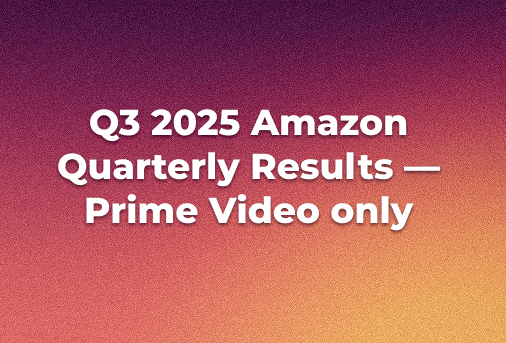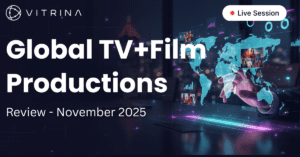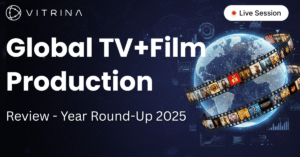Introduction (Q3 2025 Amazon Quarterly Results — Prime Video only)
This analysis isolates Amazon’s Prime Video performance drivers and risks for Q3 2025, explicitly excluding Ecommerce and AWS. Evidence is drawn primarily from Amazon IR (earnings release, 10-Q, webslides) and selectively from reputable trade reporting for context.
Because Amazon does not report a standalone Prime Video P&L, we use transparent proxies—e.g., video & music expense and capitalized content—as directional indicators, and treat “Subscription Services”/“Advertising Services” as context, not PV-only revenue. The lens is global, with emphasis on the live-sports ramp (current NFL Thursday window, NBA to follow), channel aggregation, and a measured ad-tier rollout, balanced against rising content costs and disciplined rights ROI.
Prime Video’s Aggressive Push Expected into LIVE Sports, New IP Extensions & Expansion in Third-Party Channels
A read of Amazon’s Q3 results gives interesting clues on their focus areas for Prime Video.
Live-sports audience momentum
TNF’s consistent YoY gains create a reliable, high-frequency tentpole that boosts engagement, premium sponsorships, and ad sell-through across the season.
NBA rights add year-round premium inventory
The NBA fills the calendar between NFL windows with nationally relevant, brand-safe live events and shoulder programming, improving advertiser continuity and frequency management.
YA franchise scale beyond sports (The Summer I Turned Pretty S3)
A breakout scripted hit demonstrates non-sports depth and extends into film/spin-offs, merchandising, and cross-platform promotion—stabilizing viewing outside live-sports peaks.
Channel aggregation boosts ARPU & retention
A broad Prime Video Channels marketplace (including sports/news partners) keeps users inside Prime Video with one-bill convenience, higher take-rates, and lower churn.
Prime Video Faces Challenges in Content Costs, COGS, Long-Term Sports Rights Exploitation and Freemium Upsells
Amazon’s Q3 results expose some of the 2026 challenges for the Prime Video business.
Rising content cash costs
Sports/IP inflation raises the cost base; near-term margin optics depend on ad sell-through, sponsorship mix, and disciplined amortization.
Gross accounting places content costs in COGS (optics)
Recording digital media content costs in cost of sales can mute headline gross-margin versus net-revenue models—so peer benchmarking requires context.
Long-dated sports commitments raise the execution bar
Multi-year rights require sustained audience scale and premium sponsorships each season to keep unit economics on track.
Ad-tier UX & yield sensitivity
Balancing ad load, targeting, and frequency with churn risk is delicate—especially where the ad-free upsell must remain affordable.
Prime Video’s TNF+NBA Growth Engine; Focus on Sports+News Channels; Ad-Sales Flywheel; Scripted IP Franchises
Prime Video has an awesome expansion plan. Amazon’s Q3 results throws light on the thinking behind it.
Sports portfolio as growth engine (TNF + NBA)
Pair TNF scale with NBA cadence to build a near year-round live backbone for acquisition, retention, and high-CPM sponsorships; use shoulder content to extend watch time.
Channel bundling expansion to deepen engagement
Add must-have live/sports/news channels to increase session length and multi-sub adoption, deepening the bundle’s value while sharing upside via rev-share (e.g., major sports networks via Channels).
Ad-sales flywheel via Amazon Ads
A wider cross-platform buying surface (programmatic + premium sponsorships) captures TV budgets and can improve sell-through on Prime Video inventory.
Scripted IP franchising (series → film/spin-offs)
Converting high-engagement series into films and related projects reduces marketing risk, extends IP lifecycles, and opens licensing opportunities.
International ad-tier rollout
Localized ad policies with an optional ad-free upsell broaden TAM and increase monetization flexibility while respecting regional price sensitivities.
Prime Video Senior Leadership Will Focus On Better Management of Sports, Rights-Utilization, Newer Ad Formats and Local Content
Prime Video’s leadership focus areas are very clear from the Amazon Group’s latest Q3 results.
Seasonality tailwinds in Q4
Peak sports windows create a supportive engagement and advertising backdrop into the holidays and upfront cycles.
Rights ROI discipline
Package selection, pricing, and sponsorship mix must steadily improve unit economics as rights costs escalate over the decade (especially newly acquired sports rights).
Product & UX evolution
Smarter ad formats (pause, native, shoppable) and lower-latency streams can lift yield without compromising viewer satisfaction.
Global growth levers
Expanding localized content and selective live rights in priority markets strengthens regional competitiveness and advertiser appeal.





 Seattle, United States of America
Seattle, United States of America



